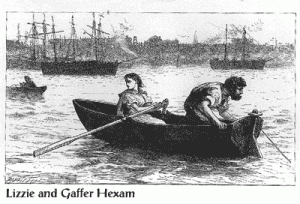Hey, CR followers. We’re breaking our summer skeleton-crew silence with a reminder, an update, and a treat.
First, don’t forget our summer contest. There’s some lovely moolah attached to the Schiff Prizes—and even if the eds don’t pick your piece to win, they may still want to publish it at our usual per-page rate ($30 for poetry, $25 for prose). In the event that we don’t opt to publish your stuff this time around, you still get a full year’s subscription to the mag, which includes bonus music features AND the 64-page, full-color graphic play MOTH, which we plan to mail out with our November issue. Illustrator Gable Ostley is hard at work and sending us new “rough inks” almost daily, and playwright Declan Greene is supplying captions and dialogue for Gabe’s sketches. The finished product is going to be amazing.
Now for the update: We just approved the final proof for our summer issue and expect the shipment in the next week or so. Our TEN-tacular issue includes last year’s Schiff Prize winners, three reviews that meditate on the staying power of the classic Moby-Dick, the usual complement of terrific stories and poems, another great translation feature, and—bonus—it will be accompanied by our latest music feature, composer Sarah Hutchings’s score for Jeff Gundy’s poem “March Ode.”
Today’s treat comprises a last delightful look at our winter number in the form of our (relatively) new blog feature Pas de Deux, in which contributors to a given issue interview each other about what intrigued, puzzled, or impressed them in the another writer’s story, poem, or essay. This installment features an exchange between Daniel A. Hoyt and Douglas Silver on the latter’s story “Found Peoples.” Check back in a couple of days for the switcheroo: Doug’s questions and Dan’s responses!
 Daniel A. Hoyt: I have lots of questions about bodies and lots of questions that seem to beget more questions. “Found Peoples” starts with such gripping, visceral language as Feng, the story’s protagonist, examines a dead body he’s fished from the river. I was immediately convinced by the body; I was there with Feng as he “pinched the green eye, and the contact lens peeled off.” How did you create these artful and disturbing states of decay? What kind of research did you do? Is this a feat of imagination, of medical textbooks, of Google?
Daniel A. Hoyt: I have lots of questions about bodies and lots of questions that seem to beget more questions. “Found Peoples” starts with such gripping, visceral language as Feng, the story’s protagonist, examines a dead body he’s fished from the river. I was immediately convinced by the body; I was there with Feng as he “pinched the green eye, and the contact lens peeled off.” How did you create these artful and disturbing states of decay? What kind of research did you do? Is this a feat of imagination, of medical textbooks, of Google?
Douglas Silver: Google is generally my first stop—be it for a spicier Massaman curry recipe or the particulars of each stage of human decomposition. Numerous websites and academic journals provided an indispensable foundation in the science of decay. I read a lot and emailed a few experts and saw many images I would like to unsee. From there, it was a matter of backtracking—from ashes to animation—and deciding upon those details that provide a glimpse into the lives of the deceased.
DH: How about your depiction of China? How did you go about imagining and creating the physical setting and the rich sociological dynamics underpinning the story?
DS: China’s abysmal record on human rights and personal expression is infamous the world over. It is a dreadful place to be writer and a fascinating place to write about. Much of the societal and physical depictions were the product of research, but the narrative atmosphere was strongly influenced by my visit to China after graduating high school. When I arrived at the airport in Beijing, I noticed a sign that read Warning: Drug Trafficking is Punishable by Death in the R.O.C. Being 18 and an idiot, I thought this a superb photo-op. Before I could put away my camera, two officers approached me. One took my luggage and emptied it in front of everyone while the other demanded my passport. When they didn’t find drugs, they repacked me (admittedly neater than I had packed myself) and welcomed me to the country. When I told someone I met about this interaction, an American who had lived in China for years, she explained how lucky I was, how much worse it would have been if I were Chinese. I sought out that airport photograph when I began the story and kept asking myself what becomes of the unlucky.
DH: Because these questions are for a Pas de Deux feature, this question seems almost mandatory: Will you discuss the way you use foils in “Found Peoples”?
DS: One of the challenges of the piece was providing the reader a palpable sense of Feng’s former life. It seemed the most organic method to achieve this was through Feng’s encounters with those who were devoted to his family, and leveraging this juxtaposition for the benefit of both characterization and narrative tension. At some point, it occurred to me that it is Feng’s contact with the living through which the reader derives the clearest prospective into Feng’s past, i.e., the life he lost. Conversely, it is his dealings with the dead that most clearly render his present life—a paradigm that is upended by his time with the young woman’s body.
DH: There’s a strangely mundane yet magical moment in “Found Peoples” when Feng thinks of and explains the story of the prodigal son. To many members of a western audience and to many western characters, that explanation is unnecessary, but Feng has to think about it in a different way. How did you discover Feng’s point of view? How do you go about shaping point of view in your stories?
DS: I’m of the belief that the surest way to figure out a character is to determine what he or she most desires. If my character doesn’t have an urgent need, then I don’t have a character. At least not one I have any right to expect readers to invest in. I start by asking myself the basics: What does CHARACTER want? Why does CHARACTER want it? What is preventing CHARACTER from getting it? In Feng’s case, while he spends his days working vigilantly and dishonorably to afford basic human necessities, he desires at his core the safe return of his family and the communal acceptance that carries. But he is powerless to achieve that desire; his sole option is faith—something he has never possessed, what divided him from his family prior to their incarceration and what he can’t acquire without them. Once I realized the paradox of Feng as a man who doesn’t believe and therefore isn’t believed in (and therefore can’t believe), I felt like I might have character worth following.
 DH: This one may seem like an assignment rather than a question, but I wish more people would read Our Mutual Friend (you too, Gentle Reader of The Cincinnati Review blog!), so here goes: As I first read “Found Peoples,” I immediately thought of Gaffer Hexam, the “night bird” in Our Mutual Friend, who, like Feng, fishes corpses from a river and strips them of valuables. Here’s a link to the opening chapter, when we first meet Gaffer and his daughter, Lizzie. Doug, I know you were initially inspired by a news article about men who retrieve dead bodies from rivers in China, but had you read Our Mutual Friend? What kind of dialogue do you see between your story and the opening of Dickens’s novel?
DH: This one may seem like an assignment rather than a question, but I wish more people would read Our Mutual Friend (you too, Gentle Reader of The Cincinnati Review blog!), so here goes: As I first read “Found Peoples,” I immediately thought of Gaffer Hexam, the “night bird” in Our Mutual Friend, who, like Feng, fishes corpses from a river and strips them of valuables. Here’s a link to the opening chapter, when we first meet Gaffer and his daughter, Lizzie. Doug, I know you were initially inspired by a news article about men who retrieve dead bodies from rivers in China, but had you read Our Mutual Friend? What kind of dialogue do you see between your story and the opening of Dickens’s novel?
DS: I’m embarrassed and grateful that I had not heard of Our Mutual Friend. Having now read the first chapter, I am not sure I would have had the confidence to write the piece had I known that none other than Charles Dickens had employed a similar conceit, especially given that both stories start out in medias res. While it appears Gaffer and Feng are not driven by similar desires, both have no qualms about plundering the dead. Gaffer’s rhetorical statement “Has a dead man any use for money? Is it possible for a dead man to have money? What world does a dead man belong to? ‘Tother world. What world does money belong to? This world. . . .” places a premium on corporeality similar to that of Feng, whose ken is viewed through the lens of materialism. Again, I have read one chapter, so my analysis might prove to be total bunk. (But I’m enjoying it thus far, as might you, Gentle Reader of The Cincinnati Review blog!)










